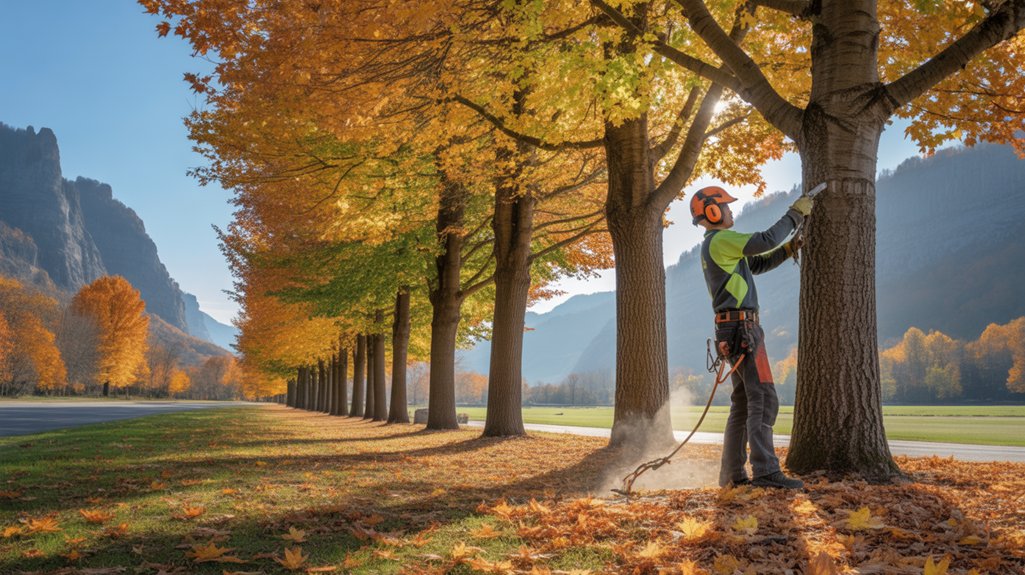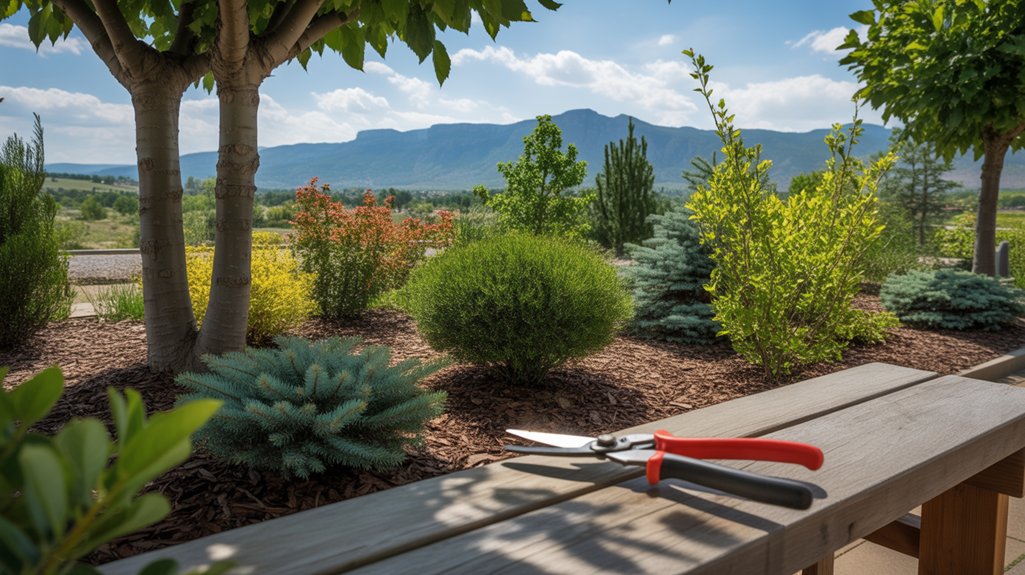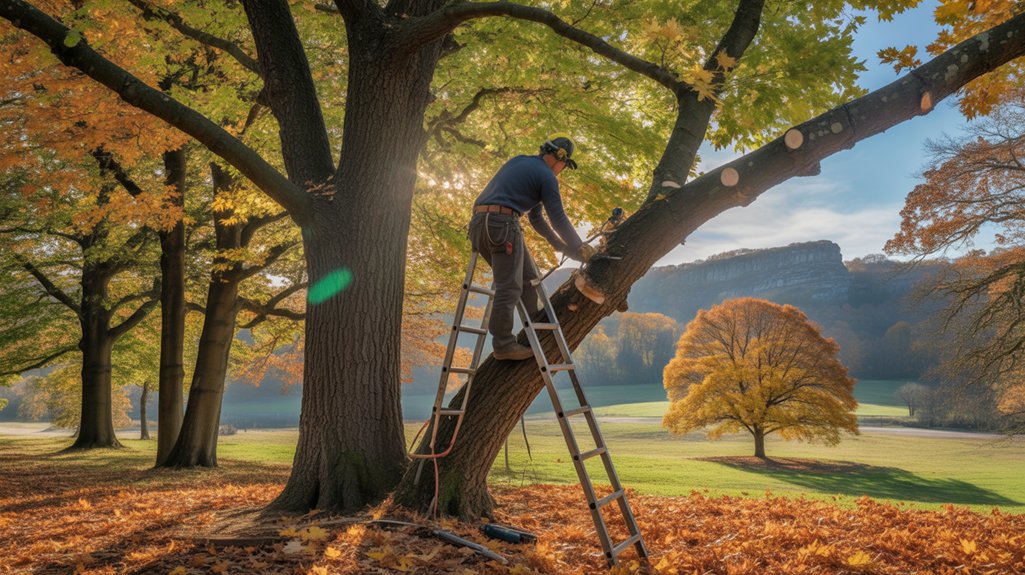If you live in Castle Rock, seasonal tree pruning in Castle Rock is vital for maintaining healthy, strong trees. Timing is critical, and knowing when to prune impacts growth and vitality. Moreover, using the right techniques and tools is equally important. Let’s explore how seasonal tree pruning in Castle Rock can help your trees thrive year-round.
Understanding the Importance of Seasonal Pruning

Seasonal pruning, supported by a tree pruning service in Castle Rock, is essential for tree health and vitality. By trimming regularly, you promote healthy growth and strengthen tree structure.
Removing dead or diseased branches allows your trees to redirect energy towards healthy limbs, leading to a stronger canopy. You’ll also notice that pruning benefits include improved air circulation and sunlight penetration, which are essential for robust growth.
Additionally, seasonal pruning helps prevent potential hazards from falling branches, ensuring safety around your home. It encourages flowering and fruiting in some species, giving you a more vibrant landscape.
Ultimately, understanding the importance of seasonal pruning will help you foster a thriving environment for your trees, making them a beautiful part of your property.
Best Times for Pruning in Castle Rock and Lone Tree

Knowing when to schedule a tree pruning service in Castle Rock and Lone Tree can make a significant difference in their health and appearance.
Spring pruning is ideal for most tree species, as it encourages new growth and helps shape the branches before the growing season kicks in. Late winter to early spring is the perfect time, just before buds swell.
On the other hand, fall maintenance is crucial for preparing your trees for winter. Pruning during this time helps remove any dead or diseased branches, ensuring your trees stay healthy and strong.
Keep an eye on local weather patterns, and choose a dry day to make your cuts, ensuring the best results for your trees’ health and longevity.
Techniques for Pruning Different Tree Species

When it comes to pruning different tree species, understanding the specific needs of each type is essential for healthy growth.
For maple pruning, aim to do it in late winter or early spring before new growth begins. Focus on removing dead branches and thinning the canopy to allow sunlight to penetrate. Be cautious not to over-prune, as maples can bleed sap if cut too early.
On the other hand, oak trimming should ideally happen in late summer or early fall. This timing helps minimize the risk of oak wilt disease.
During oak trimming, remove any crossing branches and maintain a balanced shape. Always prioritize making clean cuts to promote healing and ensure your trees thrive for years to come.
Tools You’ll Need for Effective Pruning
Pruning trees effectively requires the right tools to ensure clean cuts and promote healthy growth. You’ll need a good pair of pruning shears for smaller branches, allowing for precise cuts.
For thicker branches, consider investing in various lopper types; bypass loppers are great for live wood, while anvil loppers work well on dead wood. Don’t forget a sturdy pruning saw for larger limbs that need removal.
Safety gear is essential as well—always wear gloves and safety goggles to protect yourself from debris. With these tools, you’ll be well-equipped to tackle any pruning job and keep your trees healthy and thriving.
Proper tools make all the difference in achieving successful pruning results!
Post-Pruning Care for Healthy Trees
To ensure your trees recover well after pruning, it’s crucial to provide proper post-pruning care.
Start with post-pruning watering; trees need adequate moisture to heal. Water deeply but infrequently, allowing the soil to dry out slightly between sessions. This encourages root growth and strengthens your trees.
Next, keep an eye on tree health monitoring. Regularly check for signs of stress, such as yellowing leaves or wilting. If you notice any issues, consult an arborist for advice.
Additionally, mulching around the base can help retain moisture and regulate soil temperature.
Frequently Asked Questions
How Do I Know If My Castle Rock Trees Need Pruning?
Observe tree health during seasonal changes. Dead branches, crowded growth, or disease signs indicate a need for seasonal tree pruning in Castle Rock.
Can I Prune Trees Myself or Hire a Professional?
DIY pruning is possible, but seasonal tree pruning in Castle Rock by professionals ensures safety and precision for optimal results.
What Are Signs of Improper Pruning?
Stunted growth, dead branches, or uneven canopies suggest poor pruning techniques, impacting tree health. Hire experts to avoid issues.
How Often Should I Prune Castle Rock Trees?
Prune annually, with seasonal timing varying by species. Fast-growing trees may need more frequent seasonal tree pruning in Castle Rock.
Are There Regulations for Tree Pruning in Castle Rock?
Check local ordinances for pruning permits, especially for specific species, to avoid fines and ensure compliance.
By prioritizing seasonal tree pruning in Castle Rock, you give your trees the best chance for healthy growth and longevity. Prune in late winter or early spring for optimal results, and use fall pruning to remove dead branches. With tailored techniques, proper tools, and post-pruning care, your trees will thrive, enhancing Castle Rock’s landscape beauty.
By embracing seasonal tree pruning in Castle Rock, your trees will flourish with health and vitality, creating a stunning landscape. Regular pruning ensures safety and beauty throughout the seasons. For expert care, contact Above and Beyond Services to schedule your seasonal tree pruning in Castle Rock today.
Key Takeaways
-
Prune in late winter to early spring to promote growth and enhance tree structure.
-
Fall pruning removes dead or diseased branches, ensuring tree health before winter.
-
Use pruning shears, loppers, and saws for safe, effective trimming.
-
Monitor post-pruning health with proper watering and stress checks.
-
Choose dry days for pruning to avoid disease, guided by Castle Rock weather.




